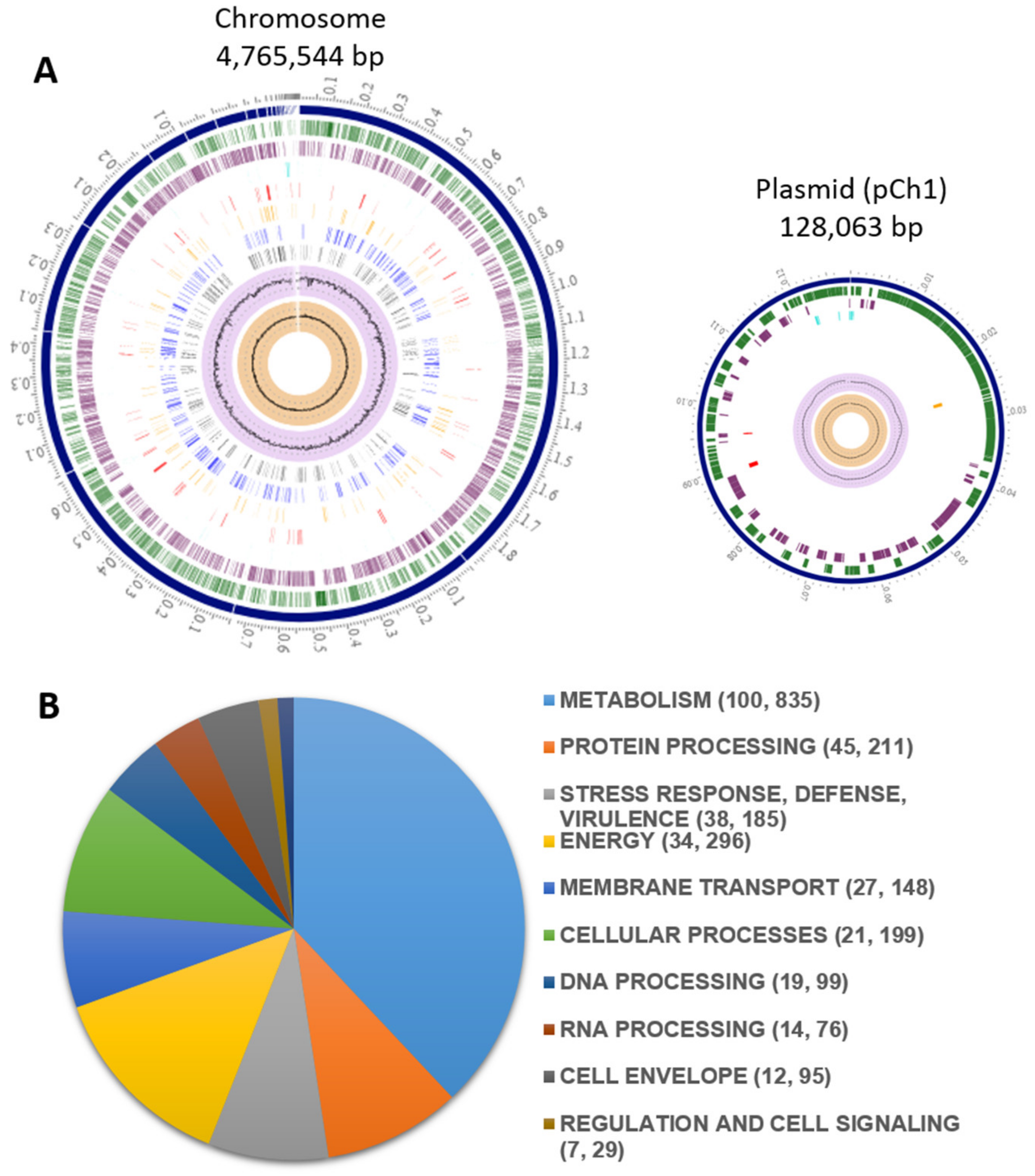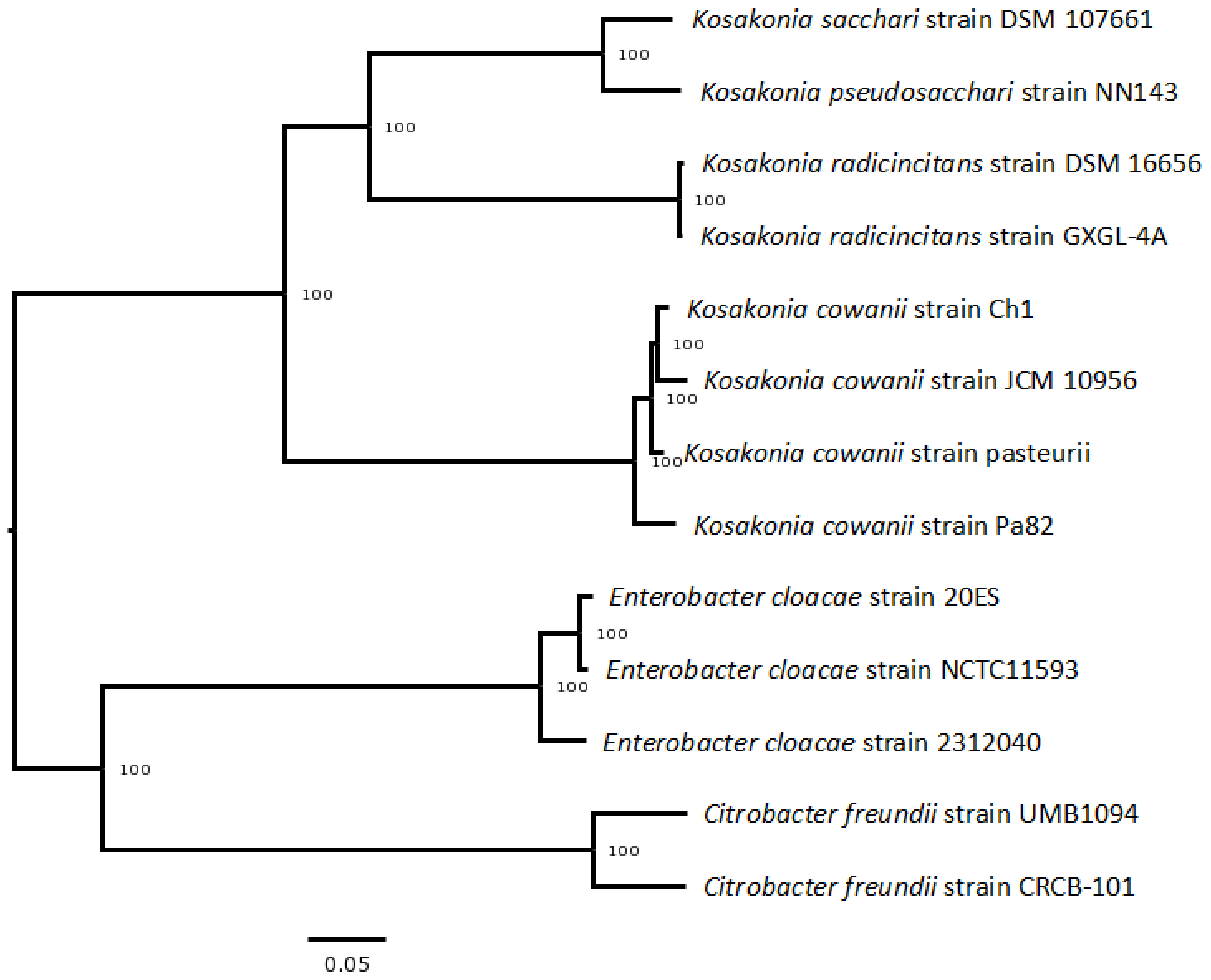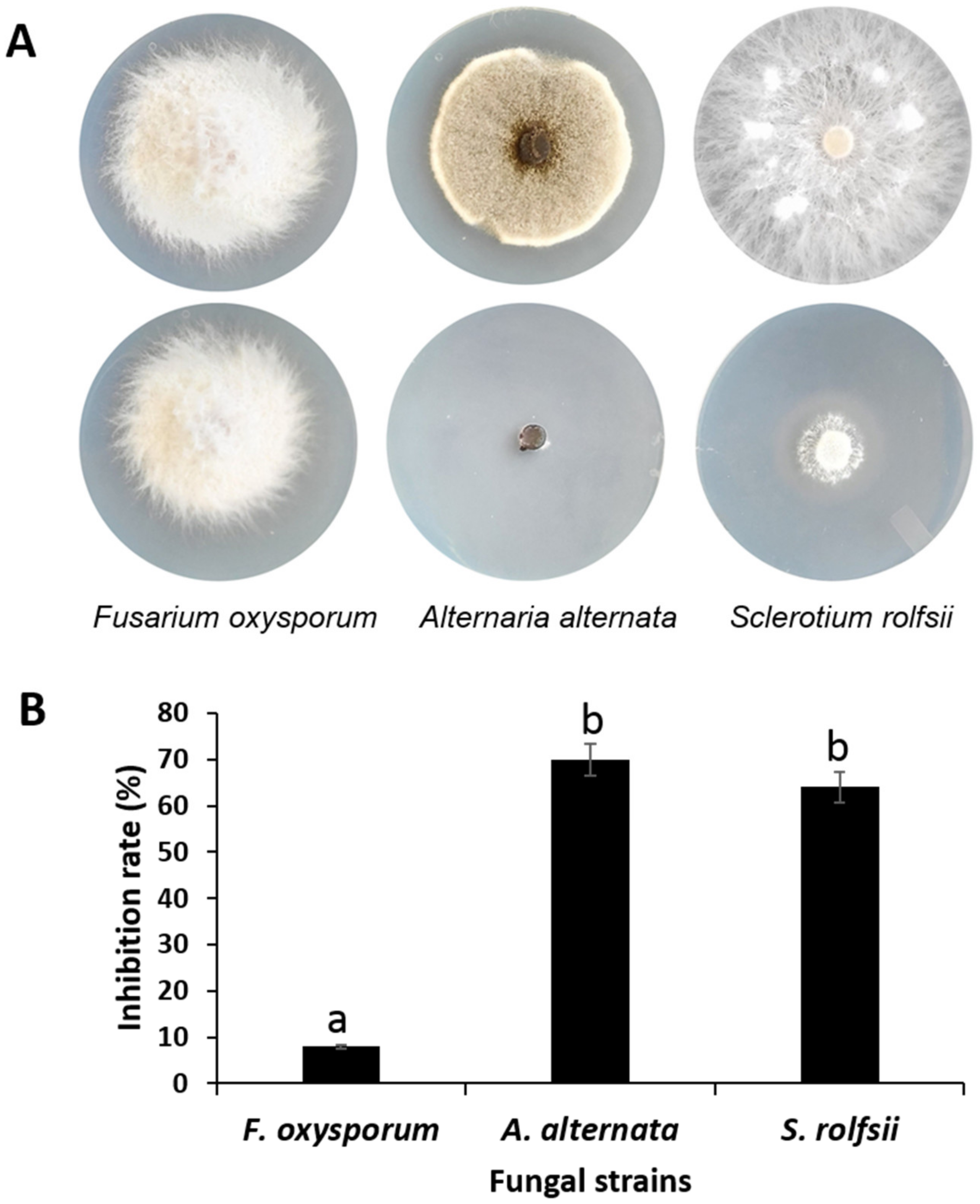Kosakonia cowanii Ch1 Isolated from Mexican Chili Powder Reveals Growth Inhibition of Phytopathogenic Fungi
Abstract
1. Introduction
2. Materials and Methods
2.1. Kosakonia Strain Isolation
2.2. Pathogenicity Test
2.3. 16s rRNA Gene Sequence Analysis
2.4. Genome Sequencing and Assembly
2.5. Inhibitory Effects of VOCs Produced by K. cowanii Ch1 on Pathogenic Fungi In Vitro
2.6. HS–SPME–GC–MS Analysis of VOCs from K. cowanii Ch1
3. Results
3.1. General Genome Features of Strain K. cowanii Ch1
3.2. Pathogenicity Test
3.3. Inhibitory Effects of VOCs Produced by K. cowanii Ch1 on Pathogenic Fungi In Vitro
3.4. HS–SPME–GC–MS Analysis of VOCs from K. cowanii Ch1
4. Discussion
Author Contributions
Funding
Institutional Review Board Statement
Informed Consent Statement
Data Availability Statement
Conflicts of Interest
References
- Brady, C.; Cleenwerck, I.; Venter, S.; Coutinho, T.; De Vos, P. Taxonomic evaluation of the genus Enterobacter based on multilocus sequence analysis (MLSA): Proposal to reclassify E. nimipressuralis and E. amnigenus into Lelliottia gen. nov. as Lelliottia nimipressuralis comb. nov. and Lelliottia amnigena comb. nov., respectively, E. gergoviae and E. pyrinus into Pluralibacter gen. nov. as Pluralibacter gergoviae comb. nov. and Pluralibacter pyrinus comb. nov., respectively, E. cowanii, E. radicincitans, E. oryzae and E. arachidis into Kosakonia gen. nov. as Kosakonia cowanii comb. nov., Kosakonia radicincitans comb. nov., Kosakonia oryzae comb. nov. and Kosakonia arachidis comb. nov., respectively, and E. turicensis, E. helveticus and E. pulveris into Cronobacter as Cronobacter zurichensis nom. nov., Cronobacter helveticus comb. nov. and Cronobacter pulveris comb. nov., respectively, and emended description of the genera Enterobacter and Cronobacter. Syst. Appl. Microbiol. 2013, 36, 309–319. [Google Scholar] [CrossRef] [PubMed]
- Yang, X.-J.; Wang, S.; Cao, J.-M.; Hou, J.-H. Complete genome sequence of human pathogen Kosakonia cowanii type strain 888-76. Braz. J. Microbiol. 2018, 49, 16–17. [Google Scholar] [CrossRef]
- Bhatti, M.D.; Kalia, A.; Sahasrabhojane, P.; Kim, J.; Greenberg, D.E.; Shelburne, S.A. Identification and Whole Genome Sequencing of the First Case of Kosakonia radicincitans Causing a Human Bloodstream Infection. Front. Microbiol. 2017, 8, 62. [Google Scholar] [CrossRef] [PubMed]
- Berinson, B.; Bellon, E.; Christner, M.; Both, A.; Aepfelbacher, M.; Rohde, H. Identification of Kosakonia cowanii as a rare cause of acute cholecystitis: Case report and review of the literature. BMC Infect. Dis. 2020, 20, 366. [Google Scholar] [CrossRef] [PubMed]
- Zhang, Y.; Wang, B.; Li, Q.; Huang, D.; Zhang, Y.; Li, G.; He, H. Isolation and Complete Genome Sequence Analysis of Kosakonia cowanii Pa82, a Novel Pathogen Causing Bacterial Wilt on Patchouli. Front. Microbiol. 2022, 12, 818228. [Google Scholar] [CrossRef]
- Krawczyk, K.; Borodynko-Filas, N. Kosakoniacowanii as the New Bacterial Pathogen Affecting Soybean (Glycine max Willd.). Eur. J. Plant Pathol. 2020, 157, 173–183. [Google Scholar] [CrossRef]
- Brady, C.L.; Venter, S.N.; Cleenwerck, I.; Engelbeen, K.; De Vos, P.; Wingfield, M.J.; Telechea, N.; Coutinho, T.A. Isolation of Enterobacter cowanii from Eucalyptus showing symptoms of bacterial blight and dieback in Uruguay. Lett. Appl. Microbiol. 2009, 49, 461–465. [Google Scholar] [CrossRef]
- Furtado, G.Q.; Guimarães, L.M.S.; Lisboa, D.O.; Cavalcante, G.P.; Arriel, D.A.A.; Alfenas, A.C.; Oliveira, J.R. First Report of Enterobacter cowanii Causing Bacterial Spot on Mabea fistulifera, a Native Forest Species in Brazil. Plant Dis. 2012, 96, 1576. [Google Scholar] [CrossRef]
- Petrzik, K.; Brázdová, S.; Krawczyk, K. Novel Viruses That Lyse Plant and Human Strains of Kosakonia cowanii. Viruses 2021, 13, 1418. [Google Scholar] [CrossRef]
- Jan-Roblero, J.; Cruz-Maya, J.A.; Barajas, C.G. Chapter 12—Kosakonia. In Beneficial Microbes in Agro-Ecology; Amaresan, N., Senthil Kumar, M., Annapurna, K., Kumar, K., Sankaranarayanan, A., Eds.; Academic Press: Cambridge, MA, USA, 2020; pp. 213–231. [Google Scholar] [CrossRef]
- Romano, I.; Ventorino, V.; Ambrosino, P.; Testa, A.; Chouyia, F.E.; Pepe, O. Development and Application of Low-Cost and Eco-Sustainable Bio-Stimulant Containing a New Plant Growth-Promoting Strain Kosakonia pseudosacchari TL13. Front. Microbiol. 2020, 11, 2044. [Google Scholar] [CrossRef]
- Shi, J.-F.; Sun, C.-Q. Isolation, identification, and biocontrol of antagonistic bacterium against Botrytis cinerea after tomato harvest. Braz. J. Microbiol. 2017, 48, 706–714. [Google Scholar] [CrossRef] [PubMed]
- Dennison, N.J.; Jupatanakul, N.; Dimopoulos, G. The mosquito microbiota influences vector competence for human pathogens. Curr. Opin. Insect Sci. 2014, 3, 6–13. [Google Scholar] [CrossRef] [PubMed]
- Celestino Hernández, A.G.; Gómez Ortiz, V.; Arvizu Gómez, J.L.; Ramos López, M.Á.; Rodríguez Morales, J.A.; Flores Macías, A.; Álvarez Hidalgo, E.; Nuñez Ramírez, J.; Flores Gallardo, F.J.; García Gutiérrez, M.C.; et al. Detection of Bacillus cereus sensu lato Isolates Posing Potential Health Risks in Mexican Chili Powder. Microorganisms 2021, 9, 2226. [Google Scholar]
- Clinical and Laboratory Standards Institute (CLSI). Performance Standards for Antimicrobial Disk Susceptibility Tests, 12th ed.; Approved Standard; Clinical and Laboratory Standards Institute: Wayne, PA, USA, 2018. [Google Scholar]
- Monciardini, P.; Sosio, M.; Cavaletti, L.; Chiocchini, C.; Donadio, S. New PCR primers for the selective amplification of 16S rDNA from different groups of actinomycetes1. FEMS Microbiol. Ecol. 2002, 42, 419–429. [Google Scholar] [CrossRef]
- Naas, T.; Oueslati, S.; Bonnin, R.A.; Dabos, M.L.; Zavala, A.; Dortet, L.; Retailleau, P.; Iorga, B.I. Beta-lactamase database (BLDB)—Structure and function. J. Enzym. Inhib. Med. Chem. 2017, 32, 917–919. [Google Scholar] [CrossRef]
- Saitou, N.; Nei, M. The neighbor-joining method: A new method for reconstructing phylogenetic trees. Mol. Biol. Evol. 1987, 4, 406–425. [Google Scholar] [CrossRef]
- Felsenstein, J. Confidence Limits on Phylogenies: An Approach Using the Bootstrap. Evolution 1985, 39, 783–791. [Google Scholar] [CrossRef]
- Jukes, T.H.; Cantor, C.R. Evolution of protein molecules. In Mammalian Protein Metabolism; Munro, H.N., Ed.; Academic Press: Cambridge, MA, USA, 1969; Volume 3, pp. 21–132. [Google Scholar]
- Kumar, S.; Stecher, G.; Li, M.; Knyaz, C.; Tamura, K. MEGA X: Molecular Evolutionary Genetics Analysis across Computing Platforms. Mol. Biol. Evol. 2018, 35, 1547–1549. [Google Scholar] [CrossRef]
- Olson, R.D.; Assaf, R.; Brettin, T.; Conrad, N.; Cucinell, C.; Davis, J.J.; Dempsey, D.M.; Dickerman, A.; Dietrich, E.M.; Kenyon, R.W.; et al. Introducing the Bacterial and Viral Bioinformatics Resource Center (BV-BRC): A resource combining PATRIC, IRD and ViPR. Nucleic Acids Res. 2022, 51, D678–D689. [Google Scholar] [CrossRef]
- Brettin, T.; Davis, J.J.; Disz, T.; Edwards, R.A.; Gerdes, S.; Olsen, G.J.; Olson, R.; Overbeek, R.; Parrello, B.; Pusch, G.D.; et al. RASTtk: A modular and extensible implementation of the RAST algorithm for building custom annotation pipelines and annotating batches of genomes. Sci. Rep. 2015, 5, 8365. [Google Scholar] [CrossRef]
- Naquin, D.; d’Aubenton-Carafa, Y.; Thermes, C.; Silvain, M. CIRCUS: A package for Circos display of structural genome variations from paired-end and mate-pair sequencing data. BMC Bioinform. 2014, 15, 198. [Google Scholar] [CrossRef]
- Ondov, B.D.; Treangen, T.J.; Melsted, P.; Mallonee, A.B.; Bergman, N.H.; Koren, S.; Phillippy, A.M. Mash: Fast genome and metagenome distance estimation using MinHash. Genome Biol. 2016, 17, 132. [Google Scholar] [CrossRef] [PubMed]
- Dmitry, A.; Mikhail, R.; Alla, L.; Pevzner, P.A. Plasmid detection and assembly in genomic and metagenomic data sets. Genome Res. 2019, 29, 961–968. [Google Scholar]
- Dennis, C.; Webster, J. Antagonistic properties of species-groups of Trichoderma: II. Production of volatile antibiotics. Trans. Br. Mycol. Soc. 1971, 57, 41-IN44. [Google Scholar] [CrossRef]
- Zhao, X.; Zhou, J.; Tian, R.; Liu, Y. Microbial volatile organic compounds: Antifungal mechanisms, applications, and challenges. Front. Microbiol. 2022, 13, 922450. [Google Scholar] [CrossRef] [PubMed]
- Hernández Gómez, Y.F.; González Espinosa, J.; Ramos López, M.Á.; Arvizu Gómez, J.L.; Saldaña, C.; Rodríguez Morales, J.A.; García Gutiérrez, M.C.; Pérez Moreno, V.; Álvarez Hidalgo, E.; Nuñez Ramírez, J.; et al. Insights into the Bacterial Diversity and Detection of Opportunistic Pathogens in Mexican Chili Powder. Microorganisms 2022, 10, 1677. [Google Scholar] [CrossRef]
- Moore, W.E.; Lai, G.K.K.; Griffin, S.D.J.; Leung, F.C.C. Complete genome sequence of SMBL-WEM22, a halotolerant strain of Kosakonia cowanii isolated from Hong Kong seawater. Microbiol. Resour. Announc. 2021, 10, e00891-21. [Google Scholar] [CrossRef]
- Gallique, M.; Bouteiller, M.; Merieau, A. The Type VI Secretion System: A Dynamic System for Bacterial Communication? Front. Microbiol. 2017, 8, 1454. [Google Scholar] [CrossRef]
- Almeida, O.A.C.; de Araujo, N.O.; Dias, B.H.S.; de Sant’Anna Freitas, C.; Coerini, L.F.; Ryu, C.-M.; de Castro Oliveira, J.V. The power of the smallest: The inhibitory activity of microbial volatile organic compounds against phytopathogens. Front. Microbiol. 2023, 13, 951130. [Google Scholar] [CrossRef]
- Lemfack, M.C.; Gohlke, B.-O.; Toguem, S.M.T.; Preissner, S.; Piechulla, B.; Preissner, R. mVOC 2.0: A database of microbial volatiles. Nucleic Acids Res. 2017, 46, D1261–D1265. [Google Scholar] [CrossRef]
- Marquez-Villavicencio, M.d.P.; Weber, B.; Witherell, R.A.; Willis, D.K.; Charkowski, A.O. The 3-Hydroxy-2-Butanone Pathway Is Required for Pectobacterium carotovorum Pathogenesis. PLoS ONE 2011, 6, e22974. [Google Scholar] [CrossRef] [PubMed]
- Ryu, C.M.; Farag, M.A.; Hu, C.H.; Reddy, M.S.; Wei, H.X.; Paré, P.W.; Kloepper, J.W. Bacterial volatiles promote growth in Arabidopsis. Proc. Natl. Acad. Sci. USA 2003, 100, 4927–4932. [Google Scholar] [CrossRef] [PubMed]
- Ryu, C.-M.; Farag, M.A.; Hu, C.-H.; Reddy, M.S.; Kloepper, J.W.; Paré, P.W. Bacterial Volatiles Induce Systemic Resistance in Arabidopsis. Plant Physiol. 2004, 134, 1017–1026. [Google Scholar] [CrossRef]
- Cho, S.M.; Kang, B.R.; Han, S.H.; Anderson, A.J.; Park, J.-Y.; Lee, Y.-H.; Cho, B.H.; Yang, K.-Y.; Ryu, C.-M.; Kim, Y.C. 2R,3R-Butanediol, a Bacterial Volatile Produced by Pseudomonas chlororaphis O6, Is Involved in Induction of Systemic Tolerance to Drought in Arabidopsis thaliana. Mol. Plant Microbe Interact. 2008, 21, 1067–1075. [Google Scholar] [CrossRef] [PubMed]
- Tyagi, S.; Lee, K.-J.; Shukla, P.; Chae, J.-C. Dimethyl disulfide exerts antifungal activity against Sclerotinia minor by damaging its membrane and induces systemic resistance in host plants. Sci. Rep. 2020, 10, 6547. [Google Scholar] [CrossRef]





| Category | Source | Genes |
|---|---|---|
| Antibiotic Resistance | CARD | 49 |
| Antibiotic Resistance | PATRIC | 60 |
| Drug Target | DrugBank | 275 |
| Drug Target | TTD | 54 |
| Drug Target | TCDB | 458 |
| Virulence Factor | PATRIC_ VF | 103 |
| Virulence Factor | VFDB | 25 |
| Virulence Factor | Victors | 128 |
| AMR Mechanism | Genes |
|---|---|
| Antibiotic activation enzyme | katG |
| Antibiotic resistance gene cluster, cassette, or operon | marA, marB, marR, bla |
| Antibiotic target in susceptible species | alr, ddl, drx, EF-G EF-Tu, folA, dfr, folP, gyrA, gyrB, inhA, fabl, lso-Trna, kasA, murA, rho, rpoB, rpoC, s10p, S12p |
| Antibiotic target protection protein | BcrC |
| Efflux pump conferring antibiotic resistance | acrAB-tolC, acrAD-tolC, acrZ, emrAB-tolC, macA, macB, mdfA/cmr, mdtABC-tolC, sugE, tolC/opmH |
| Gene conferring resistance via absence | GidB |
| Protein-altering cell-wall charge conferring antibiotic resistance | gdpD, pgsA |
| Regulator modulating expression of antibiotic resistance genes | acrAB-tolC, emrAB-tolC, H-NS, oxyR |
| Virulence Factor | Gene Name | Putative Function |
|---|---|---|
| Endotoxin | gtrB | Bactoprenol glucosyl transferase |
| Iron uptake, siderophore | entA | 2,3-dihydro-2,3-dihydroxybenzoate dehydrogenase 2,3-dihydro-2,3-dihydroxybenzoate dehydrogenase of siderophore biosynthesis |
| fepB | Ferric enterobactin-binding periplasmic protein FepB | |
| entS | Enterobactin exporter EntS | |
| fepG | Ferric enterobactin transport system permease protein FepG | |
| entB | Isochorismatase of siderophore biosynthesis | |
| Secretion system, invasion, motility | flgC | Flagellar basal-body rod protein FlgC |
| motA | Flagellar motor rotation protein MotA | |
| flgH | Flagellar L-ring protein FlgH | |
| flgB | Flagellar basal-body rod protein FlgB | |
| flgG | Flagellar basal-body rod protein FlgG | |
| fliG | Flagellar motor switch protein FliG | |
| fepD | Ferric enterobactin transport system permease protein FepD | |
| fliP | Flagellar biosynthesis protein FliP | |
| cheW | Positive regulator of CheA protein activity (CheW) | |
| fliM | Flagellar motor switch protein FliM | |
| fliC | Flagellin FliC | |
| fliA | RNA polymerase sigma factor for flagellar operon |
| Compounds | Retention Time (min) | Relative Peak Area (%) | Chemical Classes | Compounds | Retention Time (min) | Relative Peak Area (%) | Chemical Classes |
|---|---|---|---|---|---|---|---|
| Ethyl ether | 4.463 | 1.21 | Esters | 1-Hexanol, 2-ethyl- | 39.375 | 2.53 | Alcohols |
| Methanethiol | 4.698 | 0.72 | Alcohols | Benzaldehyde | 40.274 | 1.04 | Aldehydes |
| Acetaldehyde | 4.849 | 3.81 | Aldehydes | 1-Octanol | 42.284 | 1.74 | Alcohols |
| Acetone | 6.167 | 0.87 | Ketones | 2-Undecanone | 44.321 | 0.70 | Ketones |
| Butanal | 7.595 | 0.26 | Aldehydes | 2-Acetylthiazole | 45.495 | 0.53 | Other compounds |
| Ethyl Acetate | 8.016 | 0.23 | Esters | Acetophenone | 45.729 | 0.68 | Ketones |
| 2-Butanone | 8.316 | 0.84 | Ketones | Pyrazine, 2,5-dimethyl-3-(3-methylbutyl)- | 46.712 | 0.80 | Pyrazine |
| Butanal, 3-methyl- | 9.063 | 0.23 | Aldehydes | Acetic acid, decyl ester | 48.542 | 0.97 | Esters |
| Ethanol | 9.543 | 5.40 | Alcohols | 2-Tridecanol | 50.308 | 0.25 | Alcohols |
| 2,3-Butanedione | 12.212 | 2.15 | Ketones | Cyclodecane | 52.921 | 8.14 | Hydrocarbons |
| Trichloroethylene | 12.835 | 0.39 | Other compounds | 2-Tridecanone | 57.159 | 0.56 | Ketones |
| Trichloromethane | 14.49 | 0.40 | Other compounds | 3-Decen-1-ol, acetate, (Z)- | 58.32 | 0.65 | Alcohols |
| Toluene | 15.234 | 0.36 | Hydrocarbons | Benzyl Alcohol | 60.125 | 0.54 | Alcohols |
| Disulfide, dimethyl | 16.873 | 1.01 | Other compounds | Butanoic acid, butyl ester | 62.093 | 3.86 | Esters |
| p-Xylene | 21.054 | 0.16 | Other compounds | Propanoic acid, 2-methyl-, 2,2-dimethyl-1-(2-hydroxy-1-methylethyl)propyl ester | 63.338 | 1.89 | Esters |
| 1-Butanol | 21.78 | 1.74 | Alcohols | Phenylethyl Alcohol | 63.772 | 1.66 | Alcohols |
| Ethanol, 2-methoxy- | 23.334 | 0.32 | Alcohols | Ethanol, 2,2′-oxybis- | 68.499 | 0.36 | Alcohols |
| 2-Heptanone | 24.018 | 0.10 | Ketones | 2-Propenal, 3-phenyl- | 73.17 | 0.35 | Aldehydes |
| 1,3-Diazine | 24.974 | 0.50 | Other compounds | 2-Nonadecanone | 74.715 | 0.50 | Ketones |
| 1-Butanol, 3-methyl- | 25.263 | 4.88 | Alcohols | Octanoic Acid | 76.241 | 0.59 | Acids |
| Pyrazine, methyl- | 27.934 | 1.06 | Pyrazine | Triacetin | 76.669 | 0.60 | Other compounds |
| 2-Butanone, 3-hydroxy- | 29.238 | 10.60 | Ketones | Cyclododecane | 78.05 | 0.36 | Hydrocarbons |
| 2-Propanone, 1-hydroxy- | 29.823 | 0.23 | Ketones | 2,4,7,9-Tetramethyl-5-decyn-4,7-diol | 78.381 | 1.10 | Alcohols |
| Pyrazine, 2,5-dimethyl- | 30.922 | 5.86 | Pyrazine | Benzoic acid, 4-tert-butyl-, 3,5-dichloro-4-pyridyl ester | 79.344 | 0.23 | Esters |
| Pyrazine, 2,6-dimethyl- | 31.233 | 0.25 | Pyrazine | Benzoic acid, 2-amino-, methyl ester | 83.028 | 0.27 | Esters |
| 1-Hexanol | 32.78 | 0.33 | Alcohols | Cyclododecene | 84.094 | 0.30 | Hydrocarbons |
| Dimethyl trisulfide | 33.755 | 0.16 | Other compounds | Methyl 8-methyl-nonanoate | 84.442 | 0.24 | Esters |
| Pyrazine, 2-ethyl-6-methyl- | 34.201 | 0.11 | Pyrazine | Hexanedioic acid, dibutyl ester | 85.415 | 0.35 | Esters |
| Pyrazine, 2-ethyl-5-methyl- | 34.469 | 0.40 | Pyrazine | Dodecanoic acid, 3-hydroxy- | 85.692 | 1.08 | Acids |
| 2-Nonanone | 34.981 | 1.00 | Ketones | Diethyl Phthalate | 88.447 | 1.39 | Other compounds |
| Pyrazine, 2-methyl-5-(1-methylethyl)- | 35.581 | 0.13 | Pyrazine | Indole | 90.111 | 0.15 | Aromatics |
| Pyrazine, 3-ethyl-2,5-dimethyl- | 37.046 | 1.28 | Pyrazine | Homosalate | 92 | 3.09 | Other compounds |
| Octanoic acid, ethyl ester | 37.401 | 0.43 | Esters | Phthalic acid, hex-2-yn-4-yl isobutyl ester | 95.051 | 0.89 | Other compounds |
| Pyrazine, 2-ethenyl-6-methyl- | 38.835 | 0.09 | Pyrazine |
Disclaimer/Publisher’s Note: The statements, opinions and data contained in all publications are solely those of the individual author(s) and contributor(s) and not of MDPI and/or the editor(s). MDPI and/or the editor(s) disclaim responsibility for any injury to people or property resulting from any ideas, methods, instructions or products referred to in the content. |
© 2023 by the authors. Licensee MDPI, Basel, Switzerland. This article is an open access article distributed under the terms and conditions of the Creative Commons Attribution (CC BY) license (https://creativecommons.org/licenses/by/4.0/).
Share and Cite
González Espinosa, J.; Hernández Gómez, Y.F.; Javier Martínez, Y.; Flores Gallardo, F.J.; Pacheco Aguilar, J.R.; Ramos López, M.Á.; Arvizu Gómez, J.L.; Saldaña Gutierrez, C.; Rodríguez Morales, J.A.; García Gutiérrez, M.C.; et al. Kosakonia cowanii Ch1 Isolated from Mexican Chili Powder Reveals Growth Inhibition of Phytopathogenic Fungi. Microorganisms 2023, 11, 1758. https://doi.org/10.3390/microorganisms11071758
González Espinosa J, Hernández Gómez YF, Javier Martínez Y, Flores Gallardo FJ, Pacheco Aguilar JR, Ramos López MÁ, Arvizu Gómez JL, Saldaña Gutierrez C, Rodríguez Morales JA, García Gutiérrez MC, et al. Kosakonia cowanii Ch1 Isolated from Mexican Chili Powder Reveals Growth Inhibition of Phytopathogenic Fungi. Microorganisms. 2023; 11(7):1758. https://doi.org/10.3390/microorganisms11071758
Chicago/Turabian StyleGonzález Espinosa, Jacqueline, Yoali Fernanda Hernández Gómez, Yomaiko Javier Martínez, Francisco Javier Flores Gallardo, Juan Ramiro Pacheco Aguilar, Miguel Ángel Ramos López, Jackeline Lizzeta Arvizu Gómez, Carlos Saldaña Gutierrez, José Alberto Rodríguez Morales, María Carlota García Gutiérrez, and et al. 2023. "Kosakonia cowanii Ch1 Isolated from Mexican Chili Powder Reveals Growth Inhibition of Phytopathogenic Fungi" Microorganisms 11, no. 7: 1758. https://doi.org/10.3390/microorganisms11071758
APA StyleGonzález Espinosa, J., Hernández Gómez, Y. F., Javier Martínez, Y., Flores Gallardo, F. J., Pacheco Aguilar, J. R., Ramos López, M. Á., Arvizu Gómez, J. L., Saldaña Gutierrez, C., Rodríguez Morales, J. A., García Gutiérrez, M. C., Amaro Reyes, A., Álvarez Hidalgo, E., Nuñez Ramírez, J., Hernández Flores, J. L., & Campos Guillén, J. (2023). Kosakonia cowanii Ch1 Isolated from Mexican Chili Powder Reveals Growth Inhibition of Phytopathogenic Fungi. Microorganisms, 11(7), 1758. https://doi.org/10.3390/microorganisms11071758











